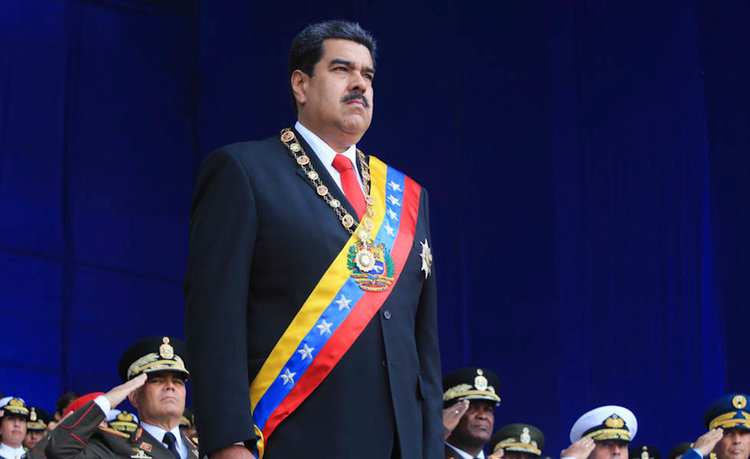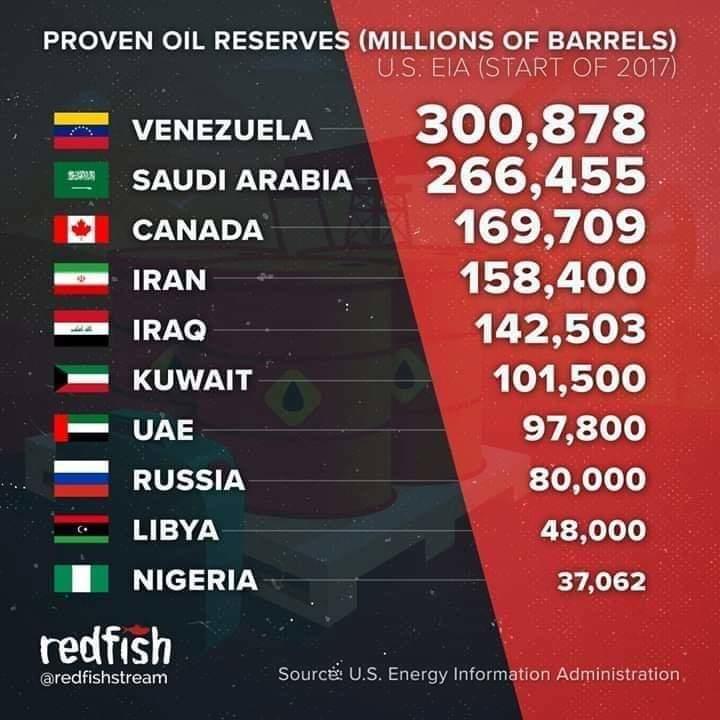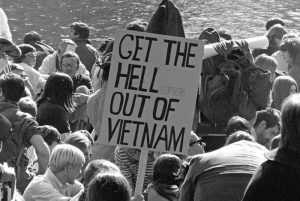
Views: 418011
INTRODUCTION
The case that will be documented here is that Venezuela’s people are suffering from a tragic national situation which actually cannot be reversed by anything that’s within the power of Venezuela’s Government to do or to block. In order to understand this very unfortunate reality (if one wants to understand it), one must first understand the relevant parts of the broader situation in the world that affects Venezuela. What’s dooming the country isn’t merely a local situation, but instead is global and environmental. It also is economic, pertaining to the role that Venezuela is playing in the global economy. But the economic factor is definitely not of the kind that it’s commonly assumed and alleged to be. It is instead very different.

Here, this very different reality will be both described and documented (instead of just founded upon assumptions — many of which are false — such as the standard, basically local, economic ‘explanation’ of Venezuela’s troubles is, which focuses on Venezuela’s socialism, or the economy’s being not sufficiently capitalist).
What it all comes down to, stated in its briefest terms, is that no nation can do anything but lose money by selling the world’s dirtiest oil, tar-sands oil, which costs $100+ to clean and produce, into a global oil market that’s paying less than $100 (currently around $65) per barrel. Venezuela was able to sell it profitably when oil-prices were high, but is getting crushed now, because its oil is no longer profitable to produce and sell. But 95% of Venezuela’s export-earnings come from oil. Unless and until oil-prices are again above $100 (which probably won’t happen again, except perhaps for very brief periods), Venezuela is doomed. Venezuela’s only chance to diversify its economy away from “the natural resources curse” (from which it especially suffers) was long ago, decades before the current Government came into power. That chance was missed. This ship is now sinking, and no one can save it. (And the US Government and its allies have no actual interest in saving it, but only in exploiting it, parasitically.)
So, here the real history and context for what is happening in and to Venezuela will be presented, and the reader will be able easily to verify any detail of it (by means of the links) — on one’s own, (not accepting anything on mere ‘authority’, which, in such a politically charged matter as this, is almost invariably propaganda). The reader can verify any allegation here simply by clicking onto the given link, at any point in the presentation that might seem to be questionable.
These links are directly to the items of evidence, in the specific case of: why Venezuela’s people are suffering.
Here is that case — the realistic case, without any propaganda, but with only credible news reports and source-documents as constituting its basis — regarding this question.

THE CASE
The two lands that produce the world’s highest-cost-to-produce oil are Canada and Venezuela. Both extract their oil overwhelmingly from tar-sands, which is the dirtiest of all oil and thus (by far) the costliest to refine. (Thus, it’s called “extra-heavy crude”, and that is the least desirable type. It’s also the type that, in a global-warming world, should remain in the ground, never be burned at all, as will also be explained here.)
An accurate summary statement in Wikipedia is that, “With present technology, the extraction and refining of heavy oils and oil sands generates as much as three times the total CO2 emissions compared to conventional oil,[20] primarily driven by the extra energy consumption of the extraction process.” That reference at “[20]” also states: “As the price of oil rises and as conventional hydrocarbon resources become scarcer, increased exploration and production activity is occurring in heavy oil, tar sands, and bitumen deposits. While these contribute significantly to the global energy …, they also contribute a greater share to… the detriment of the global environment.” (That’s referring to “a greater share” of “detriment” than normal crude does.) As another source phrased this matter in more explicit terms: “85 gallons of water, two tons of soil, 700-1200 cubic feet of natural gas, and 170 pounds of greenhouse gases make one barrel of crude oil” from tar-sands. That oil is simply not usable as-is to go into refining, like, for example, the standard Brent crude is. Furthermore, to produce that barrel of tar-sands-derived oil requires also the production of tons of sheer waste, none of which is left behind from producing normal oil. The cost of dealing with that waste is not factored into the cost of the barrels of oil. For examples, the future “impact upon water supplies,” and that “this water is polluted by toxic substances,” are not counted in. Therefore, the full cost of such oil has never been calculated. And yet, even so, everyone recognizes that tar-sands-derived oils are the costliest to produce.
On 25 January 2013, HSBC Global Research issued a landmark report, “Oil & Carbon Revisited: Value at risk from ‘unburnable’ reserves”. It defined the key concept of “Unburnable reserves: The IEA’s World Energy Outlook (2012 edition) estimated that in order to have a 50% chance of limiting the rise in global temperatures to 2ºC, only a third of current fossil fuel reserves can be burned before 2050. The balance could be regarded as ‘unburnable’.”
The oil in Canada and in Venezuela is the world’s least burnable, the most “heavy,” and therefore it’s not only the costliest to produce, but it’s also the worst environmentally. There is consequently increasing pressure upon large investment funds such as Harvard’s 39-billion-dollar endowment fund, to disinvest in fossil fuels. Because of interlocked boards of directors or trustees, and the needs that such ‘charities’ have to appeal to wealthy donors, these public pressures are often (as in Harvard’s case) ignored, but the movement toward divestment is gradually gaining strength in the less corrupt investment funds.
On 13 December 2018, the environmental organization 350.org headlined “Landmark fossil fuel divestment reached! 1000+ institutions are withdrawing investments from coal, oil and gas companies”, and announced:
The 1000th institution to divest was the Caisse des dépôts et consignations (CDC), which manages France’s public sector pensions, savings, and investments worth ˆ173 billion (USD$196 billion). It recently announced that from 2019 it will no longer invest in companies that make more than 10% of their business from coal – this implies that the top 200 companies in the coal-industry are now effectively blacklisted. …
On the momentum for divestment since 2013 – Nicolas Haeringer, an organiser who supports divestment groups globally, at 350.org said:
“This is a moral movement as well as a financial one. Just five years ago we had 181 divestment commitments and USD$50 billion shifted away from polluting industries and today we’re over 1000 and approaching USD$8 trillion dollars.”
This has already helped to drive many coal companies out of business. Though coal-mine owners and employees might lose from that, the entire world gains vastly more from it. Such a transition is called “progress.” Transition in the opposite direction — toward more bad than good — is called “regress,” or, simply, “harm.” Some people call it “conservatism,” but whatever it is, certainly isn’t progress. Not in any way. But that’s what the US Government and the Canadian Government want: extreme conservatism — not conservation. And they view Venezuela’s tar-sands oil as being a prize that they could profit from if Venezuela’s Government could be ‘persuaded’ to reduce their environmental regulations on extracting it. However, in 2012, Venezuela strengthened, instead of weakened, its environmental laws. That strengthened the motivation for the US and Canada to take over Venezuela. Hugo Chavez died in 2013, and Nicolás Maduro replaced him. Then, in 2016, Maduro instituted a new policy, to weaken environmental enforcement in Venezuela. Perhaps he was hoping that this would reduce the US-and-allied efforts to overthrow him. Venezuela’s economy was already on the ropes. The US continued its efforts to overthrow Maduro. Now desperate, he started selling off 12% of the land to international mining companies. Environmental enforcement at PDVSA also plunged, and on 24 November 2018, Bloomberg News bannered “Venezuela Is Leaking Oil Everywhere”. Apparently, the weaker Maduro gets, the worse he becomes. He had entered a doomed office as the president, and seems willing to do anything not to drown in it. Apparently, the weaker he gets, the more that US-allied billionaires want to take over the country, entirely on their own terms. It’ll be like what had already happened in Greece, when the Syriza Party there capitulated to the international financial firms in 2015, and the Government stripped pensions, education, social services, etc., and privatized the infrastructure. But the path toward that end is quite different in Venezuela.
With the world’s increasing move toward renewables, the disinvestment in oil companies will increasingly be targeted toward selling the stock in the ones that have invested the most in oil fields in Canada and Venezuela. However, the situation is radically different for Venezuela than it is for Canada. Here is why:
The biggest market for Canadian oil is just next door, the United States. Most of the oil that’s imported into the US comes from Canada. And, because most of the oil companies that are producing oil in Canada are US owned or allied (such as in UK), the US Government isn’t sanctioning Canada and trying to bring its Government down by reducing Canada’s oil-sales via sanctions, such as is the case with regard to Venezuela’s oil-sales. The US Government doesn’t need to do that in order for America’s corporations to become enabled to sell the oil that comes from Canada: they’re already selling that oil, and Canada’s Government (as well as America’s Government) is already helping America’s companies to do this. America’s and Canada’s aristocracies are allied — not only with Venezuela’s aristocracy (which wants to replace Venezuela’s existing Government), but also with each others’ aristocracy.
Furthermore, unlike Venezuela, Canada isn’t nearly 100% dependent upon its oil-sales in order to support its economy, such as Venezuela tragically is. Venezuela receives around 95% of its export-income from its oil. That’s ridiculous and, for geostrategic and geoeconomic reasons, should never have been tolerated by Venezuela’s Government, but it nonetheless has been tolerated by them — and, for many decades, not only by Venezuela’s present Government. Indeed, Oil&Gas Journal headlined on 8 February 2010, “All about Orinoco” and reported that there had been “early efforts to produce heavy crude from the [Orinoco] belt” and these efforts “led PDVSA predecessors to output by the early 1980s of 93,000 b/d.” Furthermore, “Petroleos de Venezuela SA estimated 1.18 trillion bbl of oil in place in the Orinoco in 1987 and revised that in 2006 to a median of 1.3 trillion bbl, a maximum of 1.4 trillion bbl, and a minimum of 900 billion bbl.”
At that time, Richard Turcotte, of Peak Oil Matters, warned about this report, by headlining “A Look at Venezuela”, and pointing out that:
Unlike the light sweet crude oil produced by the US and the light oil which has made Saudi Arabia such a force, the Orinoco oil is “heavy oil” found in oil sands — similar in characteristics to the tar sands bitumen found in Alberta, Canada. (See my prior post here.) The Venezuela oil is thus much harder to extract and refine, making it more costly. Significant investments of time and money are required to provide adequate refinery capabilities. Needless to say, extracting this heavy oil is a much more energy-and time-intensive effort than is the process for extracting the more familiar light crude. It is not anyone’s answer in the next few years.
Lead researcher and USGS geologist Chris Schenk admitted that their report is not asserting that the “technically recoverable” oil is in fact “economically recoverable.” That’s a significant distinction, and one that needs to be emphasized. All the presumed underground reserves in the world won’t mean much if it makes no sense to invest the time, effort, and money to try and extract them.
The USGS nonetheless estimates that a stunning 40 – 45% of that resource will be ultimately recoverable. One prominent geologist (and a former board member of Petroleos de Venezuela SA — Venezuela’s state oil company) is already on record as doubting anywhere near that amount can be recovered, and stated that much of what might actually be recoverable would in fact be too expensive to produce.
Perhaps Venezuela’s President Hugo Chavez and his predecessors were thinking that if the US Government says that this oil is an asset, then it is reasonable to consider it to be an asset; but if the US Government was instead merely aiming to get Venezuelans to think that it’s an asset so as to keep that country accepting its existing oil-monoeconomy (its over-dependence upon oil), then ultimately as the disappointment hits when the Venezuelan people experience the poverty after having hoped and tried to develop that ‘asset’, the US Government will become welcomed in, to take over Venezuela’s failing Government. Anyway, that would be a conceivable reason why the US Government would be promoting the ‘economic potential’ of the Orinoco belt. The aristocracy’s agents (in this case the petroleum industry) tend to be very clear-eyed about what’s of benefit to their paymasters. For whatever reason, the actual fact — that this oil was no asset — has remained hidden from the Venezuelan public. It still isn’t publicly acknowledged by Venezuela’s Government. Nor is it publicly recognized by America’s.
So, this tragic error (of presuming that tar-sands oil should be developed) goes back even to well before the time of Hugo Chavez. Moreover, it’s worth pointing out that the actual source of the ‘error’ is the petroleum industry itself, which, like the tobacco companies before it, constantly propagandized for increased production and sales, regardless of what the science says. A good example of that propaganda is the Editorial in Oil&Gas Journal on 24 January 2019, headlining “Costs, energy needs discredit ‘keep it in the ground’ agenda”. It says: “Preemptive opposition to oil and gas projects by ‘keep it in the ground’ activists promises needless hardship in two broad areas.” This is a denial of the entire concept of “unburnable reserves.” They want, instead, to burn it all — and even to keep prospecting to find yet more oil and gas (at this time of already greatly excessive inventories of cleaner reserves that should be burned before any of Canada’s or Venezuela’s filth is). They could lay off their entire teams of oil-explorers, who are wasting their time to find yet more dirty energy sources that won’t ever need to be used by anybody. Either these people are stupid and insane, or else they are psychopaths who care only about keeping their existing jobs and don’t care at all about the world that future generations will be experiencing. If their children knew, then what would they think of what their parents had done to the world that they will be living in?
Consequently (perhaps after — for whatever reason — listening too much to self-interested advisors), Venezuela’s Government has allowed itself to become trapped by its addiction to selling its extraordinarily filthy oil. There was no Governmental demand, no sufficient priority placed upon Venezuelan firms, for them to diversify the economy away from petroleum. Neither the present Government, nor any previous Government of Venezuela, did.
Hugo Chavez and Nicolás Maduro didn’t create this problem; but, now, and especially on Maduro’s watch, the oil-market transformations that result from the global-warming phenomenon are accelerating; and, unlike Canada, which is part of the US empire, Venezuela isn’t receiving US Government protection of its investors, and so there is no helping hand from the US Government (i.e., from America’s aristocracy) to assist Venezuela’s oil sales (such as the US does provide regarding Canada). There is, instead, to the contrary — as Venezuela’s Government has become weaker and weaker, and has less and less public support while global oil prices have plummeted — the grabbing hand, of both the US and Canadian Governments, to take over Venezuela’s Government, whose biggest sin, actually, was to have left itself open to such a take-over, by its having failed to diversify its economy away from the country’s doomed, and dooming, extraordinarily costly-to-refine, and undesirable to refine, oil. It’s now just a coffin in the ground, but it’s nonetheless still the source of virtually all of Venezuela’s export sales. No government could sustain supporting such a zombie. It’s a deadweight that’s dragging Venezuela down and economically suffocating all Venezuelans. And the documentation that this situation exists is incontrovertible:
The current WTO report on Venezuela indicates that 96.9% of the country’s exports are of “Fuels and mining products,” and that over 98% of this 96.9% consists of oils. Also shown is that the biggest five importers from Venezuela account for only 1.9% of Venezuela’s exports, and therefore all other countries account for 98.1%. So, when Venezuela loses its US market, that would mean loss of only 0.6% of its total export market.
However, America’s sanctions will additionally cause some US vassal nations such as in Europe to stop importing from Venezuela. So, Maduro is very vulnerable, indeed. Diversifying the markets (to that 98.1%) isn’t what was needed by Venezuelans; diversifying the economy was; and neither he nor his predecessors did any of that.
On February 2018, Petroleum Science headlined “Analysis of Venezuela’s oil-oriented economy: from the perspective of entropy” and reported that, “the current breakeven price has achieved to over $100/bbl in Venezuela.” Right now, oil is selling at around $65 per barrel. So, how can Venezuela make money selling its $100+ oil into the global $65 oil market? It’s just not possible, at least not sustainably. The Petroleum Science article therefore said that “it is unwise for Venezuela to count on selling raw oil to support the country’s economy,” because any per-barrel price that’s lower than Venezuela’s $100+ per barrel production cost will produce a loss on the sale of that barrel of oil, and because there will be very few if any future days when the per-barrel oil-price will again be above $100. The more that the world cuts back on petroleum and increases non-carbon energy-sources, the lower that the price of oil will become. And the more that investment funds steer clear of high-carbon firms, the lower the corporate stock of those companies will sink in value. Both investors and consumers are therefore going to be turning away from them.
When global oil prices were high, Venezuela could sell even its costly-to-refine oil profitably, but those times are now long gone and probably will never return, as the world increasingly switches away from fossil fuels. Especially tar-sands oils, such as from Canada and from Venezuela, should stay in the ground, and not only because today’s oil prices are too low to sustain selling them, but also because those extra-heavy oils are the worst to burn, from the standpoint of causing global warming.
As an example of this economic reality, a major US corporate investor in Venezuelan oil is Chevron Corporation, and Zacks Investment Research headlined on 5 October 2011, “Chevron Sees Carabobo Oil in 2012”. It stated:
According to a company executive, US energy behemoth Chevron Corp. (NYSE: CVX – News) may see the start-up of an oil field in Venezuela’s Orinoco Belt next year. The super-major is confident that it can commence production from Orinoco’s Carabobo Project 3 – which has estimated reserves of 66 billion barrels – in the third quarter of 2012. …
Chevron holds a 34% interest in Carabobo Project 3, while Venezuela’s national oil company Petroleos de Venezuela S.A. (or PDVSA) controls 60%. The remaining stake is owned by Venezuelan and Japanese firms.
Following the first production of 50,000 barrels per day, … [Chevron] is looking to boost volumes by an additional 50,000-100,000 barrels per day every two years. Carabobo 3, one of several Orinoco projects, is estimated to reach a maximum output of approximately 400,000-480,000 barrels of crude oil per day by 2016.
There is no public indication, at least not online, that even the “first production of 50,000 barrels per day” has been yet achieved, though it had been expected to occur within a year. Chevron’s 2017 Annual Report (covering the year 2016) is the latest online, and it doesn’t so much as even mention “Carabobo.” And this was after the 5 October 2011 prediction that “Carabobo 3, one of several Orinoco projects, is estimated to reach a maximum output of approximately 400,000-480,000 barrels of crude oil per day by 2016.” Clearly, that’s a poorly performing investment. Chevron’s current web-page on “Venezuela” says “Chevron has a 34 percent interest in Petroindependencia, S.A., which includes the Carabobo 3 Project,” but it provides no number of barrels of oil being produced there (if any) — not even now, in 2019. Bad investments die in silence and in obscurity, but good investments get trumpeted everywhere — and this one is being trumpeted nowhere.
Any oil sales from those fields will not only be delayed until when oil prices are again high enough to sell those dirty oils at a profit (which is increasingly unlikely ever to happen again). The investment values of those companies will likewise be especially hard hit as the problem of unburnable reserves becomes increasingly widely recognized and understood by the public. The public won’t remain ignorant and deceived about these matters forever. This is like a Ponzi scheme.
Russia’s Government seems determined never to accept this US coup imposing America’s “regime-change” upon the sovereign nation of Venezuela, and has made the decision to send military assets, and to invest both in Venezuela’s Government and in the oil company. On January 29th, Russia’s Interfax News Agency headlined in Russian, “The Ministry of Finance of the Russian Federation hopes to get external debt payments from Venezuela”. The neoconservative Jamestown Foundation remarked about that on January 31st by saying that “These debts may eventually be written off by a new opposition Venezuelan government led by the self-proclaimed interim president, Juan Guaido, if it manages to push Maduro out (see EDM, January 28, 2019). Yet, even if Maduro somehow succeeds in clinging to power with Russian help, he will hardly have the resources to service the loans.” That, unfortunately, happens to be true. The only sensible reason why Russia would be committing itself to protecting Venezuela’s sovereignty would be in order to say to Washington that America’s long string of foreign regime-changes (Iraq, Libya, Syria, Honduras, Ukraine, etc.) has now ended — to establish the principle (as Russia has recently done in Syria) that no longer will Washington’s invasions and coups be tolerated, no more conquests (additions to its empire) will be allowed. Somebody has to draw the line, finally, and the other nuclear superpower could be the one to do it. Other than that, however, Russia, like other investors, can only experience losses from investments in Venezuela. Venezuela is now an asset only in “The Great Game”. Russia’s protecting in Venezuela the principle of national sovereignty — no coups, no conquests, at all — is as moral as America’s repeatedly rejecting that principle is immoral; but, as an investment, Venezuela simply is a loss. If “The Ministry of Finance of the Russian Federation hopes to get external debt payments from Venezuela,” then Russia’s Ministry of Finance should be expecting to be disappointed in that “hope.” But that hope wouldn’t, in any case, be a sound reason for what Russia is doing there. The only “asset” to be won in Venezuela is protection of the most basic principle of international law: the independence and sovereignty of each nation. Hitler and his fascist allies, and Stalin and his communist allies, violated that principle; but now fascist America and its allies routinely violate it. Venezuela’s allies (unlike Neville Chamberlain) are supporting the foundation-stone of international law: national sovereignty and independence. For the US and its allies to reject the results of Venezuela’s (or of Syria’s or of Iran’s) elections is no basis for invalidating those results, and the US Government’s stooge Juan Guaido is simply a Venezuelan traitor, and should be treated as such, by an appropriate trial for treason. Certainly, there is no Constitutional basis for Guaido’s power-grab, despite the lies to the contrary by the putchists such as in America and its allied regimes.
All oil-exploration should therefore now stop, and existing tar-sands oil fields should simply be abandoned altogether. Only the easiest-to-refine (the “lighter”) oils should be sold and burnt right now. There is going to be a rush for the exits in the stocks of those “extra-heavy oil” companies, and the only question is when it will happen. Regarding that rush, the situation is very different in Venezuela than it is in Canada, because the US Government will delay as long as possible the collapse of Canada’s oil-sales, but the US (and Canada) want to expedite the collapse of Venezuela’s — at least until and unless the current Venezuelan coup succeeds. (And Canada’s Foreign Minister, Chrystia Freeland, did the key preparatory work for US President Trump to pull the plug on Venezuela’s Government; so, both of those governments have actually led in overthrowing and replacing Venezuela’s non-US-allied Government.)
Venezuela became addicted to selling its filthy oil, but now can only lose money with every barrel it sells of its oil. Each day of the company’s operations is simply eating the company’s seed-corn — and there is nothing like Canada has, to soften the blow. That’s not only unsustainable, it has already become a crisis, and Washington is exploiting it.
PDVSA’s latest online financial report is for 2016 and it shows that “Profit before income tax” was $16,317,000 in 2014, then $1,469,000 in 2015, and then $955,000 — less than a million dollars — in 2016. During the three-year period, “Current assets” declined from $55.2 billion to $54.6 billion, and “Current liabilities” declined from $55.7 billion to $50.0 billion. “Financial debt” declined from $40.0 billion to $33.9 billion. “Total assets” declined from $217.4 billion to $189.7 billion; and “Total liabilities” declined from $127.7 billion to $102.6 billion. Probably the company is already operating in the red now, but with every year of deteriorating infrastructure, just wearing out, with more and more and longer deferred maintenance, and with a bad long-term prospect for profitability, could the Government even sell the company? If Trump succeeds and PDVSA and every other state-owned asset in Venezuela becomes privatized, Venezuela’s citizens will be left with nothing, and the only beneficiaries will be the international bankers, even as international investors will need to take haircuts on their existing Venezuelan loans. The oil that PDVSA sells shouldn’t even be bought; it should simply remain in the ground.
According to the latest public information, PDVSA showed less than a million dollars of profit in 2016 — and the trend was downward. Anyone in Venezuela who thinks that the country can be sustained in the future, as it was in the past, from the sale of Venezuela’s exceptionally costly-to-produce oil, isn’t taking into account the broader picture, and the impact that the global-warming phenomenon will inevitably have upon the fossil-fuels industries.
There may be ways to jiggle the books to make PDVSA fool some investors into buying the company, but only the international bankers would be profiting from a sale of that firm.
Foreign Policy magazine, which represents America’s aristocracy, headlined on 5 June 2018, “It’s Time for a Coup in Venezuela”, but even if that turns out to be the final solution to the Venezuelan problem for America’s aristocrats, it won’t solve anything for the Venezuelan public — basically like Hitler’s “final solution” did nothing to benefit Germany’s Jews. Germany’s aristocracy did nothing for Jews then, and America’s aristocracy will do nothing for Venezuelans now. They’re all on their own. The leaders of the US-allied nations don’t want to save them, and instead follow in the fascist and Nazi tradition. The leaders in Venezuela’s current Government, who want to save them, simply can’t save them. It’s far too late for them to start now, to do what needed to start back in “the early 1980s of 93,000 b/d” from Venezuela’s Orinoco belt — which would have been for them to stop what ought never even to have been started there: extraction of that oil.

CONCLUSION
The poverty and violence that now rack Venezuela result from a broader situation in which selling what shouldn’t even be bought has run its miserable course until the final act, which is a Government that has reached the stage where it can produce income only for international bankers and for the aristocrats who control them. Any oil company now that would want to buy those assets would merely be adding to its assets — chiefly the dirty oil in the ground — ‘assets’ (oil reserves) that can never even be used (unless the propaganda becomes even more effective in the future than it has always been until now, which might be impossible to achieve). Oil companies already have lots more of that dangerous filth than anyone except people in finance will ever be able to benefit from buying or selling.
For Venezuelans, this is a great tragedy. The US and its allies are (and have been) doing everything they can to exploit the tragedy.
It’s like a hungry lion chasing a fleeing exhausted deer, who now is finally trapped.
That’s the ugly reality.

Originally published on 2019-02-10
About the author: Eric Zuesse is an American writer and investigative historian
Source: Strategic Culture Foundation
Origins of images: Facebook, Twitter, Wikimedia, Wikipedia, Flickr, Google, Imageinjection & Pinterest.
Read our Disclaimer/Legal Statement!
Donate to Support Us
We would like to ask you to consider a small donation to help our team keep working. We accept no advertising and rely only on you, our readers, to keep us digging the truth on history, global politics and international relations.








